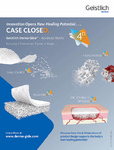An unusual presentation of postaxial polydactyly of the foot

Use this link to cite
http://hdl.handle.net/2183/29535Collections
- Investigación (FEP) [507]
Metadata
Show full item recordTitle
An unusual presentation of postaxial polydactyly of the footAuthor(s)
Date
2017-10Citation
López-López D, Becerro-de-Bengoa-Vallejo R, Losa-Iglesias ME, Bautista Casasnovas AL. An unusual presentation of postaxial polydactyly of the foot. Int Wound J. 2017 Oct;14(5):811-812. doi: 10.1111/iwj.12700. Epub 2016 Dec 2. PMID: 27910230; PMCID: PMC7950129.
Abstract
[Abstract] A 6-month-old Caucasian baby is described with a postaxial polydactyly of the letf foot. Radiographic examination revealed the accessory digit was composed of soft tissue, some with a tiny osseous element, originated from around the metatarsophalangeal joint, defined by floating type (FT). The parents had consistent difficulty putting shoes. We encountered an exceedingly rare presentation of FT, to our inspection, had neither been previously related in published studies. To the best of our knowledge, this represents the unusual case of congenital deformity lesion on the left foot to be reported in the medical literature.
Keywords
Congenital foot deformity
Deformidad congénita del pie
Postaxial poydactyly
Polidactilia postaxial
Toe phalanges
Falanges del pie
Deformidad congénita del pie
Postaxial poydactyly
Polidactilia postaxial
Toe phalanges
Falanges del pie
Editor version
Rights
Acceso abierto






